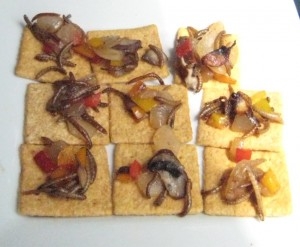EcoMyths: Why eating bugs is good for your health and the environment
By Kate Sackman

EcoMyths: Why eating bugs is good for your health and the environment
By Kate SackmanWhat would it taste like to eat a cricket? That’s what I wondered recently while watching a mother bird feed its fat, hungry babies. As it happens, Chicago’s Brookfield Zoo has an insect chef serving crickets on the weekends this summer, so I had the chance to find out!
While at Brookfield’s Xtreme Bugs exhibit, I tasted crickets prepared two ways: toasted with Cajun spices (tastes like crunchy sunflower seeds) and in sweet banana-cricket pancakes. No legs and no antennae tickled my tongue – just crunchiness. I could not bring myself to eat the mealy bug larvae cookies. But talking with the chef who prepared the bug delicacies gave me confidence, as she is also a trained entomologist (insect scientist). With her expertise, I knew she would only serve up safe and tasty bug food to a wary public.
Raising animals, especially cattle, to fulfill the human demand for meat, is costly both financially and environmentally (as explained further in our latest EcoMyths article). According to a report by the Food and Agriculture Organization of the United Nations, “livestock now use 30 percent of the earth’s entire land surface” and are a major source of deforestation around the world. The livestock sector also produces significant levels of greenhouse gases, mostly from manure, including 65 percent of human-produced nitrous oxide, a much more damaging greenhouse gas than even CO2. So, could eating bugs replace some of our craving for meat? We think so.
Even Angelina Jolie and her kids enjoy crickets as snack food. So what is holding us back from relying more on insects as a food source?

“I think they are missing the boat because, really when people learn more about them they discover that bugs are actually really cool and do all sorts of interesting things,” says Dr. Margaret Thayer, a curator in the Division of Insects in the Field Museum of Natural History’s Zoology Department. And she reminds us that bugs are essential elements of our earthly food chain: “If they all suddenly disappeared, everything would collapse.”
Andre Copeland, interpretive programs manager at Brookfield Zoo agrees. “Bugs are responsible for aerating soil, pollinating crops, and providing food to many animals. Many vertebrates – reptiles, birds, and mammals – wouldn’t survive if not for arthropods.”
So, what about humans eating bugs? Well, insects are part of the animal phylum called arthropods, which are all invertebrates that have external skeletons (“exoskeletons”) and jointed limbs, which includes insects, spiders, and crustaceans. In the U.S. we already eat many arthropods, such as lobster, crab, and crayfish. So we are already happily eating animals closely related to insects. Thayer reminds us that insects are “a concentrated source of protein and fat” which is why they are such a valuable food source in so many cultures. “If you live in a village where termites are flying from a giant mound, thousands of them flying around, you can just pick them up and eat them, or roast them.”
Margaret’s words rang in my ears as I crunched the Cajun-spiced crickets at the Zoo last week and asked myself, “could I get used to this?” If I close my eyes while chewing and block out the visual, I think I actually could. Care to join me for a termite taco?